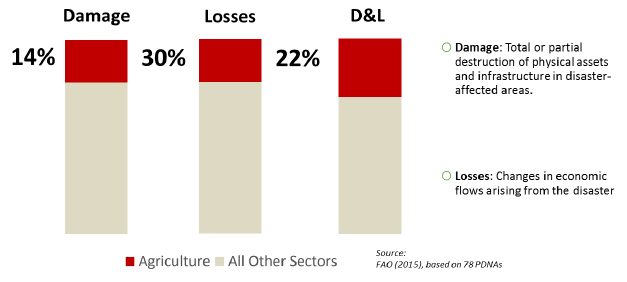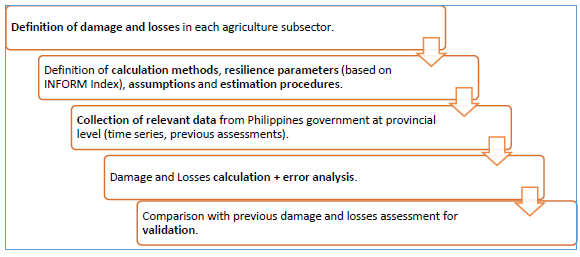Guest post by Piero Conforti – Food and Agriculture Organization (FAO), Statistics Division
Disasters are increasing
Over the last decades, disasters triggered by natural hazards have become more frequent and more severe. An increasing number of climatological, hydrological and meteorological events have posed major threats to world’s population. The cost associated with natural disasters is also growing significantly. According to the 2015 Report of the UN Secretary-General on the Implementation of the International Strategy for Disaster Reduction, “economic losses have reached an average of USD 250 billion to USD 300 billion a year”.

There is a large impact in agriculture
Agriculture forestry and fisheries are severely affected by these natural disasters, as they involve a close interplay of human activities with the natural environment. This is especially the case of weather and climate related disasters, such as drought, floods and storms, among others. FAO has calculated that about 22 percent of the impact of disasters in developing countries directly affects farmers, fishers, pastoralists and forest- and treecrops-dependent people. This share raises to more than 80 percent when only drought is considered.

The Sendai Framework for Disaster Risk Reduction (SFDRR) 2015-2030 recognizes disaster risk reduction as an important component of sustainable development. Evidence shows that investing in disaster prevention and preparedness is four to seven times more cost-effective than to rely on emergency response.
Still, little information is available on in agriculture
In spite of such significant impact of disasters on crops, livestock forestry and fisheries, the monitoring of the associated damage and losses at national, regional and global levels is quite insufficient. Data is seldom systematically recorded or reported by governments or non-government agencies, nor collected in enough detail within existing global databases on disaster losses.
Good data is key to drive investment that can turn countries, and their economic activities, more resilient to disasters. It is known that the scale and magnitude of the impact is widely diverse depending upon the context in which the disaster hits. The same magnitude of a typhoon or a drought can create havoc in some countries, and virtually no impact in others that enjoy a high degree of resilience. Technical and institutional infrastructure can make a huge difference in minimizing the impact of infrequent and unexpected events.
Building more resilience requires more and higher-quality data. Gaining a full and coherent understanding of the magnitude and diversity of disaster impact on agriculture and its sub-sectors is key to drive investment towards improving resilience, and towards enhancing the ability to cope with an increasing number of unexpectedly hazardous events.
One of the strategic focuses of FAO is enhancing resilience, by providing decision-makers with sound data and information to target investments and actions in disaster risk reduction in agriculture.
How to get better data?
In this framework, the FAO has taken action to obtain specific, standardized and comparable data for monitoring damage and losses suffered by agriculture, and their consequences in terms of food security conditions. Focus is on the multiple threats that can impact the sector, recording immediate physical damage caused by disasters on agricultural assets, as well as on the cascading negative effects of disasters on agricultural production, and value chains.
- Different types of hazardous events will be considered in the FAO initiative, including: natural hazard-induced disasters, such as geophysical and climate-related disasters – droughts, floods, fires, landslides, volcanic eruptions, tsunamis, earthquakes, storms, extreme temperatures, hailstorms, and others. Among these, particular attention should be devoted to silent, neglected disasters, which intensely affect a limited number of people.
- Food chain emergencies of transboundary or technological threats, such as transboundary plant, forest, animal, aquatic and zoonotic pests and diseases, food safety events, radiological and nuclear emergencies, dam failures, industrial pollution, oil spills.
- Man-made disasters, such as conflicts and civil unrests.
The new dataset that FAO is building, by collecting data from member countries, will provide policy-makers, and stakeholders at large, with a sound information base for decisions making. It will allow implementing ex-ante cost-benefit analysis of prevention and post-disaster resource allocation. An expert consultation was held at FAO in June 2016 with key national and international stakeholders, to discuss how to develop a sound dataset.
A new methodology to obtain accurate information
The methodology starts from an international definition of damage and losses in the crops, livestock, fisheries, aquaculture, and forestry sub-sectors. For each of these sectors, two main components are considered: production, assets and community.

The production sub-component measures disaster impact on production inputs and outputs. Damages include, for instance, the value of stored inputs (e.g. seeds) and outputs (e.g. crops) that were fully or partially destroyed by the disaster. Production losses refer to declines in the value of agricultural production resulting from the disaster.
The assets sub-component measures disaster impact on facilities, machinery, tools, and key infrastructure related to agricultural production. Crop-related assets include, among others, irrigation systems, machinery, equipment; livestock-related assets include sheds, storage buildings; fisheries assets include ponds, hatcheries, freezers and storage buildings, engines and boats, fisheries equipment; forestry assets include, among others, standing timber, firebreaks and watch towers, forestry equipment and machinery, fire management equipment. The monetary value of (fully or partially) damaged assets is calculated using the replacement or repair/rehabilitation cost, and accounted under damage.
The assessment of each components takes into account the degree of resilience, as quantified by the parameters linked to Vulnerability and Lack of coping capacity the INFORM Index for Risk Management.
Testing the new methodology
Typhoon Haiyan, locally known as Yolanda, hit the central Philippines on 8 November 2013. Winds registered at over 300 km per hour. The storm surges of Haiyan reached up to over 5 meters of height, causing widespread devastation and loss of lives in the affected coastal provinces. As of November 11, the typhoon had caused at least 6,300 deaths, affected an estimated 16 million people, and damaged or destroyed more than 1.1 million houses, as reported by the National Disaster Risk Reduction and Management Council.
The calculation of monetary impact of Typhoon Haiyan on the agriculture sector of the Philippines offers an opportunity to test the methodology described above. The assessment is conducted at provincial level, making use of primary data on disaster’s physical damage from previous impact assessments conducted by the Government of the Philippines. When primary data were missing, estimation procedures are implemented based on secondary information to fill data gaps. Error analysis is associated through the implementation of a ‘Max-Min’ interval procedure applied to the exogenous parameters included in the methodology, e.g. resilience parameters. The main steps followed in the analysis are summarized below.

Preliminary results show that the most affected agricultural sub-sectors are crops, followed by fisheries and livestock, and that losses may be relatively higher than damage.
For further information contact Piero Conforti – FAO, Statistics Division






